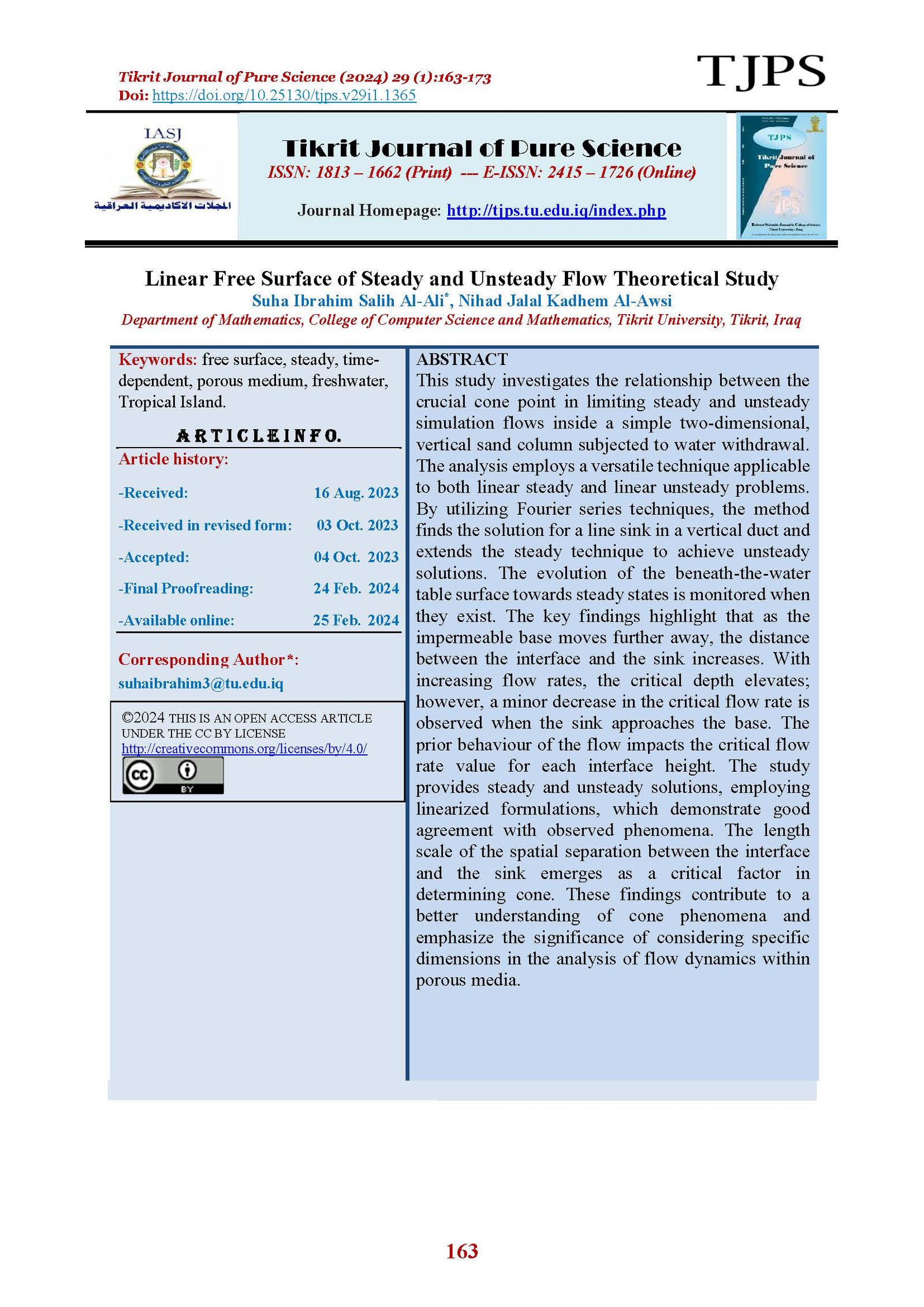Linear Free Surface of Steady and Unsteady Flow Theoretical Study
Main Article Content
Abstract
This study investigates the relationship between the crucial cone point in limiting steady and unsteady simulation flows inside a simple two-dimensional, vertical sand column subjected to water withdrawal. The analysis employs a versatile technique applicable to both linear steady and linear unsteady problems. By utilizing Fourier series techniques, the method finds the solution for a line sink in a vertical duct and extends the steady technique to achieve unsteady solutions. The evolution of the beneath-the-water table surface towards steady states is monitored when they exist. The key findings highlight that as the impermeable base moves further away, the distance between the interface and the sink increases. With increasing flow rates, the critical depth elevates; however, a minor decrease in the critical flow rate is observed when the sink approaches the base. The prior behaviour of the flow impacts the critical flow rate value for each interface height. The study provides steady and unsteady solutions, employing linearized formulations, which demonstrate good agreement with observed phenomena. The length scale of the spatial separation between the interface and the sink emerges as a critical factor in determining cone. These findings contribute to a better understanding of cone phenomena and emphasize the significance of considering specific dimensions in the analysis of flow dynamics within porous media.
Article Details

This work is licensed under a Creative Commons Attribution 4.0 International License.
Tikrit Journal of Pure Science is licensed under the Creative Commons Attribution 4.0 International License, which allows users to copy, create extracts, abstracts, and new works from the article, alter and revise the article, and make commercial use of the article (including reuse and/or resale of the article by commercial entities), provided the user gives appropriate credit (with a link to the formal publication through the relevant DOI), provides a link to the license, indicates if changes were made, and the licensor is not represented as endorsing the use made of the work. The authors hold the copyright for their published work on the Tikrit J. Pure Sci. website, while Tikrit J. Pure Sci. is responsible for appreciate citation of their work, which is released under CC-BY-4.0, enabling the unrestricted use, distribution, and reproduction of an article in any medium, provided that the original work is properly cited.
References
[1] Panday, S., Langevin, C. D., Niswonger, R. G., Ibaraki, M., and Hughes, J. D. (2013). An unstructured grid version of MODFLOW for simulating groundwater flow and tightly copled processes using a control volume finite-difference formulation. US Geological Survey Techniques and Methods, book, No.6-A45. [2] Chen, K. (2018). Heat and Chemical Transport in Aquifers at Different Geological Setting. Texas A&M University (Doctoral dissertation). [3] Sophocleous, M. (2005). Groundwater recharge and sustainability in the High Plains aquifer in Kansas, USA. Hydrogeology Journal, 13, 351-365. [4] Fetter, C. W., and Fetter, C. (2001). Applied Hydrogeology, 4th edition, Prentice Hall Upper Saddle River, USA. [5] Krásný, J., and Sharp, J. M. (Eds.). (2007). Groundwater in Fractured Rocks: IAH Selected Paper Series, volume 9 (Vol. 9). CRC Press. [6] Bear, J. (1972). Dynamics of fluids in porous media. Elsevier, New York. Dynamics of fluids in porous media. Elsevier, New York. [7] Bear, J. (2013). Dynamics of fluids in porous media. Courier Corporation, american elsevier publishing company INC. NEW YORK, pp: 757. [8] Dagan, G. (2012). Flow and transport in porous formations. Springer-Verlag Berlin Heidelberg, GmbH. [9] Muskat, M., & Wycokoff, R. D. (1935). An approximate theory of water-coning in oil production. Transactions of the AIME, 114(01), 144-163. [10] Ya, P. (1962). Theory of Ground Water Movement. Pelageya Yakovlevna Polubarinova-Kochina, USA. [11] White, F. M., and Majdalani, J. (2006). Viscous fluid flow (Vol. 3, pp. 433-434). New York: McGraw-Hill. [12] Harr, M. E. (2012). Groundwater and seepage. Courier Corporation, New York, San Francisco, Toronto, London. [13] Stoker, J. J. (2017). Water waves: The mathematical theory with applications (Vol. 36). John Wiley and Sons. [14] Boyun, G., & Lee, R. L. H. (1993). A simple approach to optimization of completion interval in oil/water coning systems. SPE reservoir engineering, 8(04), 249-255.
[15] Kundu, P. K., Cohen, I. M., and Dowling, D. R. (2015). Fluid mechanics. 3th edition, Academic press, Elsevier. [16] Debnath, L., and Debnath, L. (2005). Nonlinear partial differential equations for scientists and engineers, 4th edition, Birkhäuser, Boston, Berlin: 528-529. [17] Whitham, G. B. (2011). Linear and nonlinear waves. John Wiley and Sons, INC, PP:629. [18] Wang, Z., Countryman, A. M., Corbett, J. J., and Saebi, M. (2022). Economic and environmental impacts of ballast water management on Small Island Developing States and Least Developed Countries. Journal of Environmental Management, 301, 113779. [19] Lucas, S. K., BLAKE, J., and KUCERA, A. (1988). Water coning in oil reservoirs. Univ. of Wollongong, Dep. Math., Honours Thesis, 23. [20] Al-Ali, S., Hocking, G. C., Farrow, D. E., & Zhang, H. (2022). A spectral modelling approach for fluid flow into a line sink in a confined aquifer. European Journal of Applied Mathematics, 33(5), 960-981.
